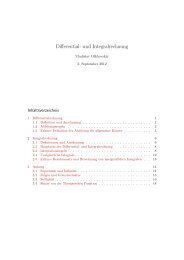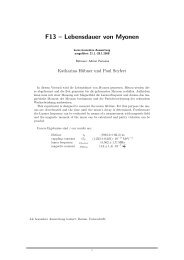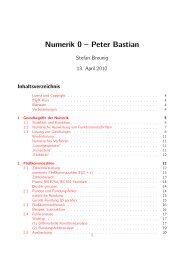Extrasolar Moons as Gravitational Microlenses Christine Liebig
Extrasolar Moons as Gravitational Microlenses Christine Liebig
Extrasolar Moons as Gravitational Microlenses Christine Liebig
You also want an ePaper? Increase the reach of your titles
YUMPU automatically turns print PDFs into web optimized ePapers that Google loves.
Chapter 1<br />
Introduction<br />
Astronomy, and in particular the search for planets outside our solar system, begins<br />
to touch what h<strong>as</strong> long been a question reserved for philosophers to ponder about:<br />
Do other worlds exist?<br />
After centuries of speculation and research, it w<strong>as</strong> less than two decades ago<br />
when it w<strong>as</strong> confirmed for the first time that planets exist in the universe that circle<br />
stars other than our sun. By now hundreds have been detected with five different<br />
techniques that are described in the overview below. For all we know, none of<br />
these extr<strong>as</strong>olar planets offer physical conditions permitting any form of life. But<br />
the search for planets potentially harbouring life and the search for indicators of<br />
habitability is ongoing. One of these indicators might be the presence of a large<br />
natural satellite – a moon – which stabilises the rotation axis of the planet and<br />
thereby the surface climate.<br />
This work sets out to simulate and evaluate the success rate of one of the most<br />
promising techniques for detecting extr<strong>as</strong>olar moons. This technique is gravitational<br />
lensing. The deflection of light by m<strong>as</strong>sive bodies is a consequence of the theory of<br />
general relativity and h<strong>as</strong> been experimentally verified since 1919. It is now the<br />
b<strong>as</strong>is for diverse are<strong>as</strong> of research in <strong>as</strong>tronomy, because of its ability to work <strong>as</strong> a<br />
magnifying gl<strong>as</strong>s to make distant or small objects visible that could not be detected<br />
otherwise. Even small-m<strong>as</strong>s objects like planets can leave a detectable mark in<br />
Galactic gravitational lensing events. While a lensing star p<strong>as</strong>sing in front of a<br />
background source star can be detected <strong>as</strong> a transient brightening of the source,<br />
the gravitational influence of a planet in orbit around the star can be detected <strong>as</strong><br />
an irregularity in this brightening. The method is sensitive to m<strong>as</strong>ses <strong>as</strong> low <strong>as</strong> an<br />
Earth m<strong>as</strong>s. From theoretical works about planet formation we know that m<strong>as</strong>sive<br />
moons can exist in stable orbits around giant planets. Therefore it is promising to<br />
apply the technique of gravitational lensing to the search for extr<strong>as</strong>olar moons.<br />
Overview of different methods for finding extr<strong>as</strong>olar planets. . .<br />
The following list provides a brief overview of the various techniques that have<br />
successfully discovered extr<strong>as</strong>olar planets in the l<strong>as</strong>t years, with a reference to the<br />
3










